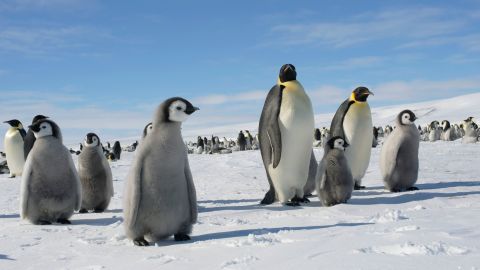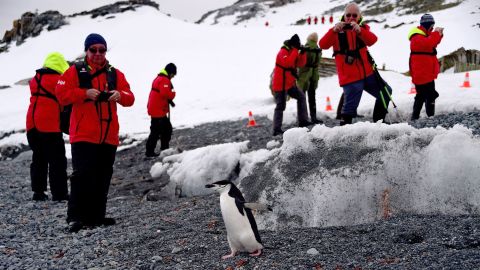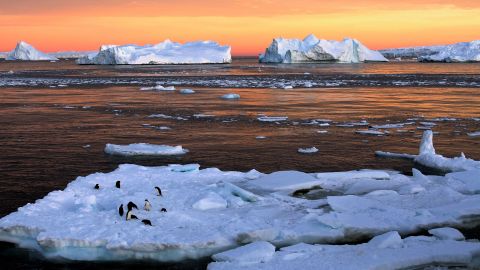CNN
—
It’s only a matter of time before human-caused climate change and pollution hit Earth’s most isolated continent. Antarctica’s pristine landscape is already changing as global temperatures rise, and new research suggests most of the region’s plant and animal species — including its iconic penguins — are in trouble.
The study, published Thursday in the journal PLOS Biology, found that 65 percent of Antarctica’s native species — with emperor penguins at the top of the list — could disappear by the end of the century if the world continues on business-as-usual and fails to keep the planet in check — Fossil fuel emissions warming.
The study also shows that current conservation efforts in Antarctica are not working on this rapidly changing continent. The researchers concluded that implementing an additional layer of cost-effective strategies they propose in their study could save up to 84 percent of Antarctica’s fragile biodiversity.
“Antarctica doesn’t really contribute to climate change; there aren’t large numbers of people living there, so the biggest threats to the continent come from outside the continent,” Jasmine Lee, the study’s lead author, told CNN. Global action, and more local and regional conservation efforts, give Antarctic species the best chance of surviving in the future. ”

Antarctica’s geographic isolation has long protected the continent from the worsening effects of the climate crisis and other environmental catastrophes plaguing the rest of the world, such as wildfires, floods and droughts. Scientists have observed dramatic changes in its northern counterpart, the Arctic, which is warming four times faster than the rest of the planet.
But the effects of climate change are only just beginning to be felt in Antarctica. For example, recent data show that sea ice in Antarctica is declining faster now than it did decades ago.
Disappearing sea ice threatens several species of marine seabirds, such as emperor and Adélie penguins, that rely on ice for nesting from April to December, research showed Thursday. If the ice melts or freezes earlier in the season due to warmer temperatures, it will be difficult for the penguins to complete their breeding cycle.
“These iconic species, such as the Emperor and Adélie penguins, are at risk and it is sad to think that Antarctica is one of the last great wildernesses on Earth, where human impact is being seen and felt,” Lee said. “It’s incredibly sad to think that we can push these species toward extinction.”
Human presence and activity in the area is also increasing. The study shows that scientific expeditions and infrastructure are expanding, while annual visitor numbers have soared more than eightfold since the 1990s.
Another study earlier this year suggested that increased human activity in the region is causing more snow to melt. Scientists have discovered that black carbon — the black, dusty pollutant from burning fossil fuels — is deposited where people spend a lot of time. Even the smallest amount of this contamination can have a significant effect on melting.

While the threats to Antarctica species and their ecosystems are increasingly well documented, they are not widely understood by policymakers, Lee said. Finding conservation funding can be challenging.
But the study suggests several measures that are actually cost-effective, estimating the cost at $1.92 billion over the next 83 years, or about $23 million a year — a small fraction of the global economy.
These strategies include minimizing and managing human activity, traffic and new infrastructure, and protecting native species while controlling non-native species and diseases entering the area.
It also includes a focus on external policies, such as achieving broader international climate goals under the 2015 Paris Agreement, which aims to reduce global warming emissions and avoid a sharp rise in global temperatures.

“Doing something about climate change is good for human health, livelihoods and the economy,” Lee said. “The incentive is there, but it’s just finding the initial investment, and it just depends on priorities.”
Cassandra Brooks, an assistant professor at the University of Colorado Boulder who has conducted extensive research on Antarctica’s marine animals, said the study was “timely and important” and could draw attention to serious threats to Antarctic biodiversity.
“This study builds on previous work and shows the urgency with which policymakers need to act on climate change if there is any chance of protecting Antarctic biodiversity,” Brooks, who was not involved in the study, told CNN. It “shows very clearly that current conservation strategies are insufficient to do anything but support biodiversity decline.”
The latest research comes days after negotiators at the UN Biodiversity Summit in Montreal reached a landmark agreement to better protect the planet’s vital ecosystems, including a pledge to protect 30 per cent of land and ocean by 2030 .
With the climate crisis now the most pervasive threat to Antarctic biodiversity, Lee said there is a greater need than ever to influence global policy to save one of Earth’s vast, pristine biomes.
“This is just the tip of the iceberg,” Lee said. “We’re at this huge tipping point right now, not just in Antarctica, but globally, in terms of climate. We have a chance to stop it, and if we don’t act now, the impacts will be worse than they could be Much more.”